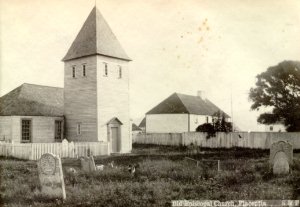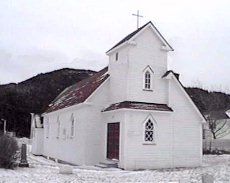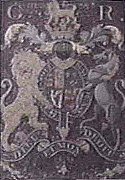
The Old Site and its First Church
The quaint little Anglican Church of St. Luke's at Placentia, although less then a hundred years old in material structure is richly enshrined in ancient history and stands on one of the oldest church sites in North America.
Pieces of broken and mouldering tombstones from the historic church yard inscribed in the Basque language are the only known relics of their kind in North America. They take us back in history to 1592, when an English captain named George Drake visited Placentia and found many vessels of Basque fisherman stationed there. Another stone, which is in Braille is dated 1676. These and other stones in the church yard, which date in the 1700's support the belief that this was the area chosen by the French to build their first church, after they had taken possession of Placentia as their capital, in 1662.
Looking into the past centuries of religious history of the Anglican Church at Placentia, it is interesting to note that while it is not stated specifically when the first Anglican Church was built, records indicate that in 1689 a church identified as "The Church of Our Lady of Angles" was built by the French on the same site where St. Luke's Anglican Church stands today. As far as can be determined this was the original church built on this old site.
The First Anglican Ministers and The New Anglican Church
The first Anglican Minister was Rev. Robert Kilpatrick who arrived in Placentia in 1729. he was the first clergyman in Placentia since the Recollects of Brittainy, who used The Church of Our Lady of Angles from 1692 to 1713, when they abandoned the church and left Placentia. Rev. Kilpatrick used this French Chapel during the three months he stayed in Placentia.
The next Anglican minister in Placentia was Rev. Edward Langman, who came as a missionary in 1759. He found seventy families of Anglicans living there. He tried to arouse the people to repair their church which had fallen into decay.
After Rev. Langman's visit in 1759, there was a period of non activity in the life of the Anglican Church in Placentia until 1787. During that year some of the principal Anglicans of Placentia petitioned the S.P.G. (Society for the Propagation of the Gospel in Foreign lands) for an Anglican minister. The S.P.G. were able to send Rev. John Harris to be the new resident minister in 1787.
Upon arrival he found that the original church, "The Church of Our Lady of Angels", had been removed and that nearly all the population had converted to the Roman Catholic Church. This step backwards, for the church, was the result from the absence of an Anglican Church and minister to lead them.
During the same year (1787) Prince William, Duke of Clarence, who later became King William IV of England, was stationed at Placentia. He was the surrogate and the appointed Lieutenant Governor of Placentia and the surrounding areas. He ordered the building of a new Anglican church and donated fifty guineas toward the cost of its construction. With the help of Mr. Brown, the first magistrate of Placentia, Rev. Harris was able to complete the church in 1788. This is the same church that is shown in a picture below.

Rev. Harris was transferred to St. John's in 1790 and was succeeded by Rev. Evens who remained until 1810. He was succeeded by Rev. G. A. Spencer who remained until 1819. He was the last resident minister in Placentia of that era.
Prince William's Gift and Centennial Celebration
 During Christmas of 1788, after completion of the
Anglican church, Prince William donated a communion set to the new church
where he worshipped with other members of the congregation. This same
communion set is held in a vault in St. John's for safekeeping. It was brought
back to Placentia for a brief period in 1962 when Placentia celebrated her
trecenternal year, in 1986 in on the two-hundredth anniversary of the church
and again in 1997 as part of the Matthew visit to Placentia in 1997.
During Christmas of 1788, after completion of the
Anglican church, Prince William donated a communion set to the new church
where he worshipped with other members of the congregation. This same
communion set is held in a vault in St. John's for safekeeping. It was brought
back to Placentia for a brief period in 1962 when Placentia celebrated her
trecenternal year, in 1986 in on the two-hundredth anniversary of the church
and again in 1997 as part of the Matthew visit to Placentia in 1997.
Facts of Interest About St. Luke's

This Quaint and captivating little church is further enriched in it's uniqueness by some interesting facts, which help to mold its religious and historic life.
As far as can be determined, when the twentieth century was in it's teens there was only two Anglican families (the Bradshaws and Crouchers) living in Placentia. In 1925 one member of the Bradshaw family died, and the service was held in the church and burial was in the old church yard.
The church bell, used today, is the first bell ever to be rung in the Anglican church during its centuries of religious life in Placentia. It was donated to the church by the Canadian National Railway during the 1950's. The bell has its own history as it was from a steam locomotive that once ran between St. John's and Port-aux-Basque.
 Hanging on the church wall, in a
rough wooden frame, is an old coat of arms which was painted during the reign
of King George III of England, who reigned from 1760 to 1820. It was from
England and placed in the new church of 1788 by Prince William while he was
stationed at Placentia. The detail of the drawing represent the
"The Order of Garter" and bears two inscriptions in foreign language.
When translated the inscriptions read, first "God and my Strength" and the
second "Evil is who Evil Thinks."
Hanging on the church wall, in a
rough wooden frame, is an old coat of arms which was painted during the reign
of King George III of England, who reigned from 1760 to 1820. It was from
England and placed in the new church of 1788 by Prince William while he was
stationed at Placentia. The detail of the drawing represent the
"The Order of Garter" and bears two inscriptions in foreign language.
When translated the inscriptions read, first "God and my Strength" and the
second "Evil is who Evil Thinks."
St. Luke's During the 1940's
At this time, the little church held the distinction of being the smallest church in Newfoundland, having only five seats on one side of the church and seven on the other side with a total seating capacity of about fifty people. It had to be enlarged to accommodate the Anglican families who moved into the area to work on the U.S. Navel Base at Argentia.
During the early years of this era when the late Rev. G. Camp, from Whitbourne mission, visited Placentia to hold church services for the few Anglican families living there, it was necessary to cover the windows with pieces of cardboard to keep out the cold or rain, before service could be held.
With the coming of religious minded Anglican families to the area also came a resurgence of new life to the almost forgotten church which by this time was destined to become a decaying monument to the memory of a long history of the Anglican church at Placentia.
An Appeal for financial help was organized through Anglican Synod Office at St. John's and sufficient funds were realized to repair the church, once again making it a comfortable and impressive place in which to worship and worthy to be called a House of Prayer.
St. Luke's Today
St. Luke's today is part of the Anglican Mission of Whitbourne. Services are held on a weekly schedule and on special for the small occassion congregation who live in the surrounding area. This small, dedicated, congregation keep the church and its surrounding property in good repair.
Centuries of past history of the Anglican faith, past glory of life in an ancient capital and one close association with royalty are all entwined in the plain wooden structure of this little church, which, only a few short decades ago, was a fading symbol, representing past greatness, threatened by the grip of extinction.
Today the enlivened church stands on the old historic site symbolic of strength and fortitude. Like an eternal flame she has passed through many periods of darkness and despair but her light still shines today as when it was first ignited by Rev. Kilpatrick, when he baptized the first ten Anglican children in the old French Chapel in 1729.